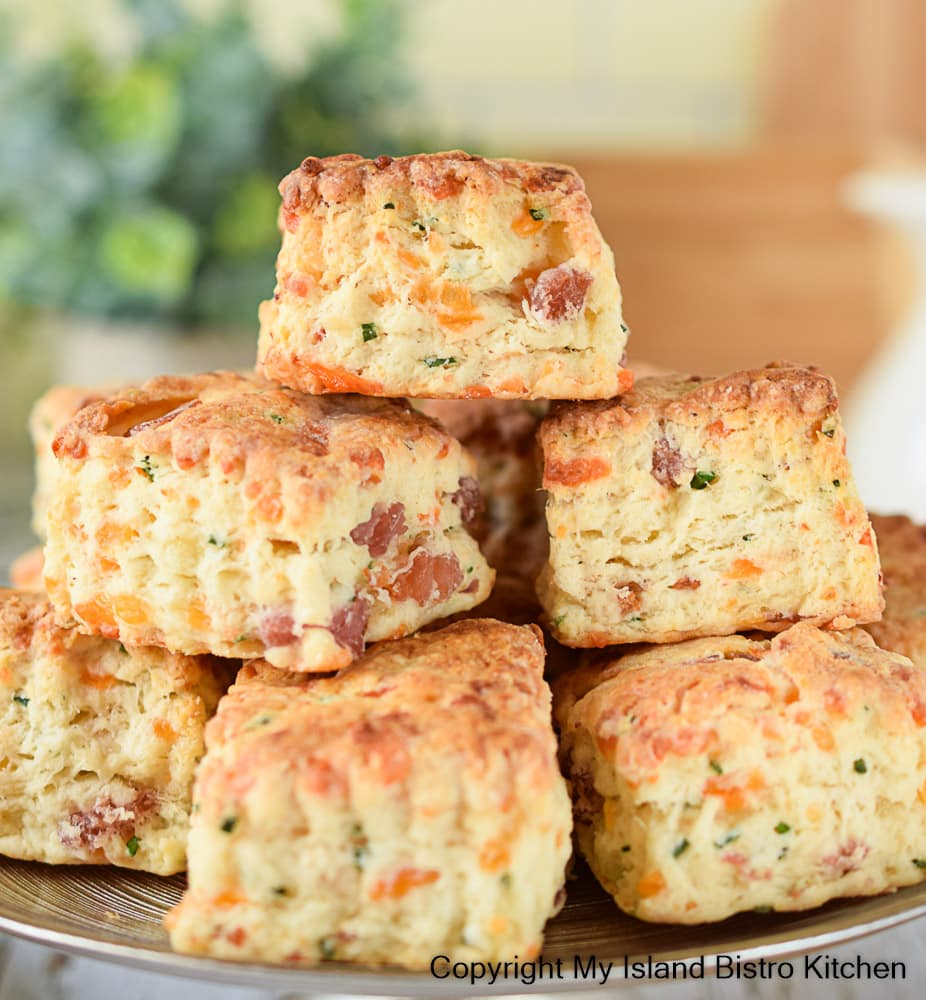
Today, I am sharing my recipe for Ham, Cheese, and Chives Savory Scones. When we think of scones, we typically think of rich scones that are topped with jam and clotted cream or English double cream, served alongside a lovely pot of tea. However, savory scones are equally tasty and are wonderful to serve warm with nothing more than a slather of good butter for morning tea, brunch, lunch, or even as a side accompaniment to a hearty bowl of chowder.
The photo below shows the scones served with my Creamy Ham and Potato Chowder. Garlic and Onion Chive Butter top the scones.
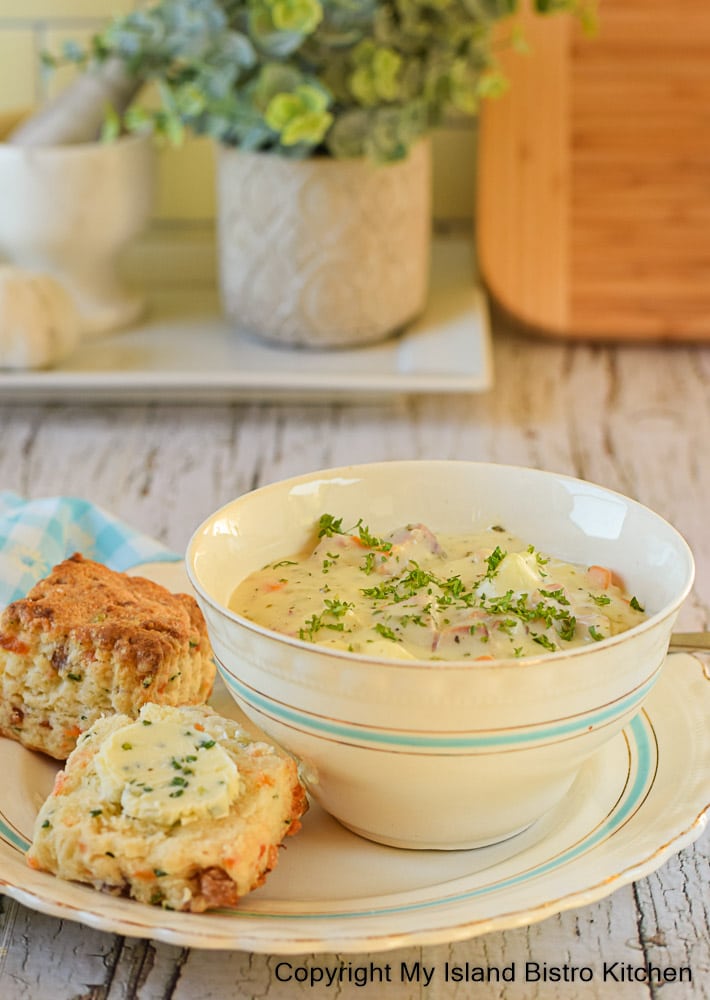
So, what makes these scones savory? Simply, the add-ins of ham, cheese, chives, and seasonings. This scone recipe is great to make when you have a small amount of leftover cooked ham – it takes 3.5oz/100 grams of cooked ham so not a lot is needed. The scones may also be made with a good quality deli ham as well (just ensure that the thickness of the deli meat is cut to ¼“ (6.35mm thick).
As we know, ham and cheese has been a longstanding favorite combination with many so, in this recipe, we will be adding 3oz/84 grams of shredded aged cheddar cheese to complement the ham. In order for the flavor to stand out, use a good quality mature cheddar cheese. Fresh chives add flavor and stud the scones with delightful speckled bits of bright green. Dried chives are not recommended for this recipe.
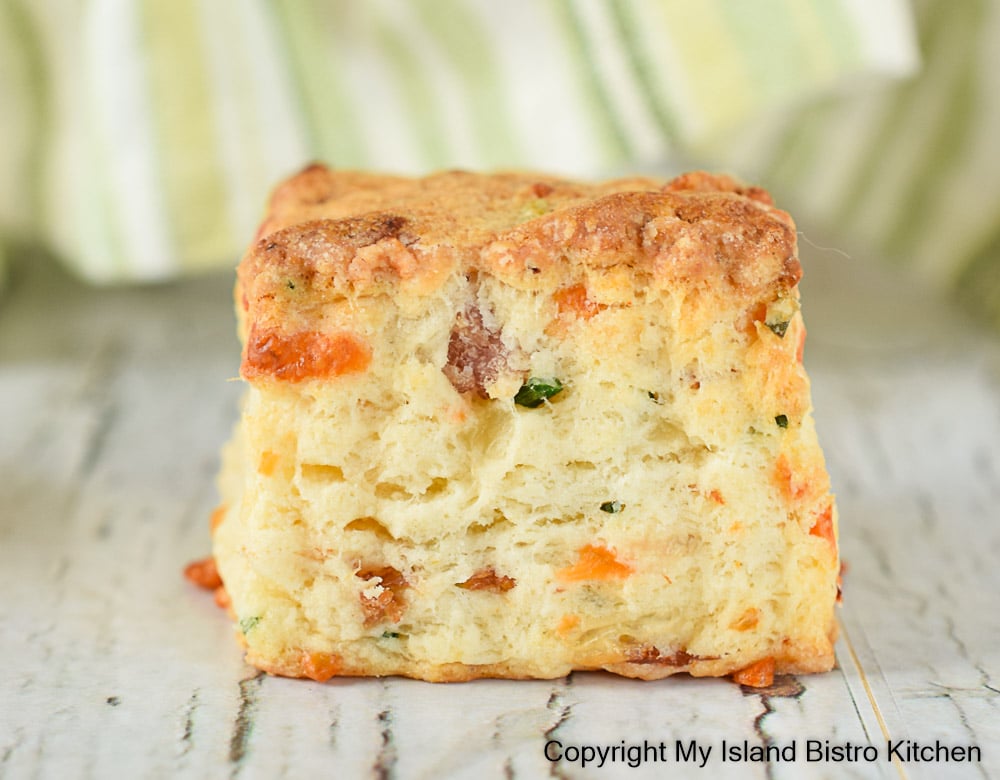
A small amount of garlic powder, onion powder, and either cayenne pepper or paprika add some flavor notes. Each of these is a personal taste and I have given a suggested scale amount of 1/8 – ¼ tsp for the garlic and onion powders and 1/16 tsp for the cayenne or paprika. Use your judgment and personal taste preferences to determine how much of each of these to add (or, leave them out altogether, if you wish).
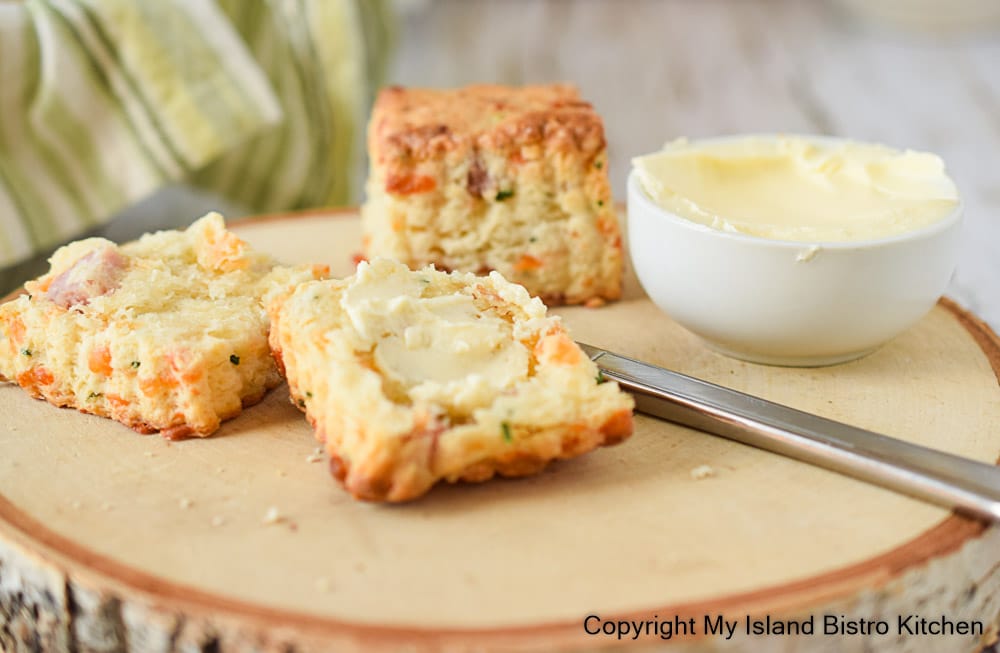
There are various methods for making scones and I am using a technique today that I refer to as the “letter-folding” technique, almost the same one as I use for my Cheddar Cheese Biscuits but, this time, we’re going to step it up a notch by adding some melted butter into the process. So, we will be folding the dough into thirds, much like folding a business letter. And, as we do that, each time we roll, or pat, the dough out into a rectangle, we will be brushing the dough with slightly cooled melted butter before folding it up again. This will provide additional richness and tenderness to the scones. And, as we know, when butter meets the oven heat, steam is created that pushes the dough up into desired flaky layers in the scones and, of course, this is going to help them rise to their maximum height. While this method can be used for any scones, this is the one I like to use especially when making scones that have add-ins that are somewhat heavy, like ham, for example, as steam from the added butter gives the dough an extra boost in the rising department.
With this method, because we want to keep the melted butter layers in place, I recommend cutting out square-shaped scones with either a sharp knife or bench scraper so there are no dough scraps to be gathered and re-rolled. In addition to keeping the butter layers in place, the other benefit of simply cutting square scones in one cutting from the dough is that it reduces handling of the dough repeatedly as, the more times scone dough is handled, the greater likelihood of gluten formation taking over and creating tough scones.
A sharp-edged 2” (5.08cm) square cookie cutter can be used and the scones cut close enough together that there are no scraps to be gathered up and re-worked for cutting. In the scones photographed for this post, I used my 2” ruffle-edged cutter and had no scraps to be re-rolled. A round 2” (5.08cm) cookie cutter can be used, if desired, but there will be some re-gathering of dough scraps required.
I won’t go into all the details on making scones here as I have written extensively about it in a post called “How to Make Perfect Scones” which readers can access by clicking here.
Scones, of course, are best served still slightly warm from the oven on the day they are made. That said, these scones freeze quite well and re-heat nicely for a few seconds in the microwave.
So, the next time you have some cooked ham on hand, make a batch of these Ham, Cheese, and Chives Savory Scones.
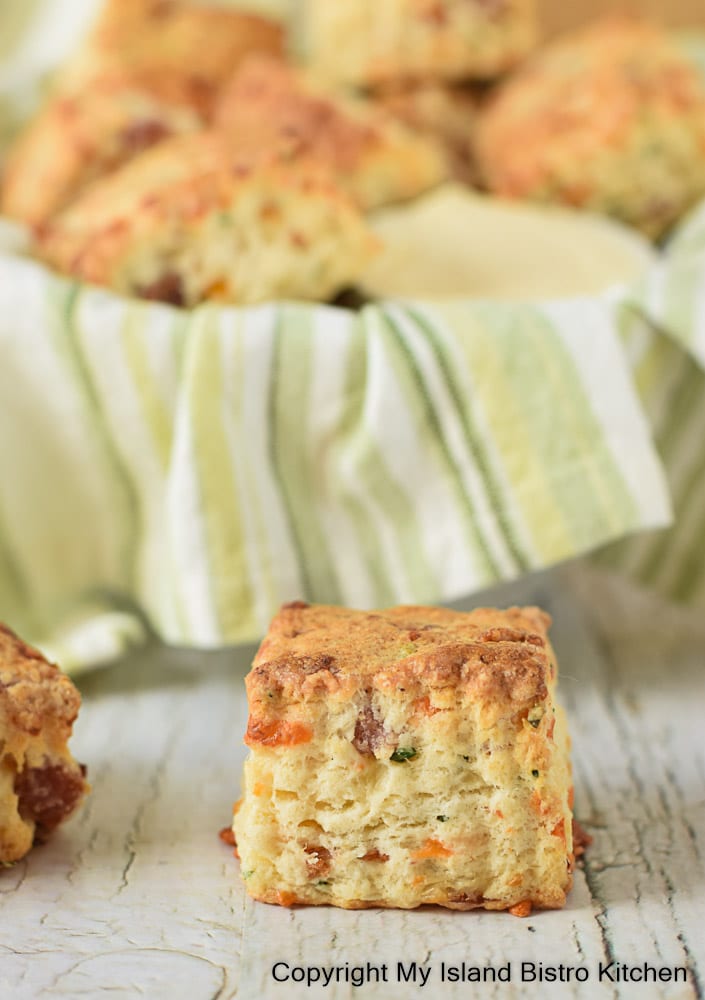
Ham, Cheese, and Chives Savory Scones
Ingredients:
2 cups all-purpose flour (10 oz/282g – See Note 1 below)
1½ tbsp granulated sugar
1 tbsp baking powder
Scant ½ tsp fine sea salt
1/8 – ¼ tsp garlic powder
1/8 – ¼ tsp onion powder
1/16 tsp cayenne or paprika
½ cup cold unsalted butter, cut into ½“ cubes
3 oz/84 grams shredded aged cheddar cheese
3.5oz/100 grams diced cooked ham (diced into ¼“/6.35mm cubes)
3 tbsp finely chopped fresh chives
1 large egg (cold), lightly beaten with fork
½ cup heavy whipping cream (35%-36%MF) (cold) (with 3/4 tbsp removed and reserved for brushing tops of scones) [no substitutes]
¼ cup whole milk or 10%MF cream (cold)
Approximately 2½ – 3 tbsp melted and cooled butter (plus 1 – 1½ tbsp more if you wish to brush scone tops with melted butter instead of whipping cream)
Method:
Line large baking sheet with parchment paper.
In large bowl, sieve or sift the flours, sugar, baking powder, salt, garlic and onion powders, and cayenne or paprika together. Drop the cubes of butter into the dry ingredients and toss to coat the butter. Cut in the butter with a wire pastry cutter until mixture resembles coarse crumbs or pea-sized pieces. Quickly run fingers through the mixture several times, scooping up bits of the butter here and there and rubbing them into long paper-thin slivers between the thumb and forefinger. It is not necessary to do this with every single piece of butter – just quickly pick several at random.
Stir in the shredded cheese, diced ham, and chopped chives. Make a well in the center of the dry ingredients.
In a small bowl or large measuring cup, lightly whisk the egg, whipping cream, and milk (or 10%MF cream) together, just until blended. Pour liquid ingredients all at once into well in center of dry ingredients. Using a fork, stir dough just enough that the liquid is absorbed into the dry ingredients and the dough can be roughly brought together. Dough will be soft and sticky and some floury spots may remain. Transfer dough onto lightly floured work surface, gently working it just until the dry ingredients are barely incorporated and a shaggy dough mass forms. Bring dough together into a ball.
Roll, or pat, the dough into a rectangle about ¾” (apx. 1.9cm) thick. Brush lightly with half of the melted butter. With dough positioned so the short ends of the rectangle are facing you, and with the aid of a large bench scraper, fold one third of the dough up from the bottom short edge into the center and then fold the other top third down onto the top of the folded two-thirds of dough, just as if folding a business letter. Roll, or pat, the dough down into another rectangle, again about ¾“ (apx. 1.9cm) thick. Brush with remaining melted butter. Fold the dough in half, this time from one of the long sides, finally rolling, or patting, the dough into a neat, tidy rectangle about ¾“ – 1” (apx. 1.9cm – 2.54cm) in thickness.
Using a sharp knife or bench scraper, cut the dough into apx. 14-16 equal-sized squares (each apx. 2” wide), depending on actual thickness of dough. Place scones, about 1” (2.54cm) or so apart, on prepared baking sheet and place in freezer for about 20 minutes (or in refrigerator for 30-35 minutes) to chill and allow butter to firm up.
To make square- or round-shaped scones using a sharp-edged cookie cutter:
Cookie cutters, instead of a knife or bench scraper can be used to cut out scones. Use a lightly floured, sharp-edged, 2” (5.08cm) square or round cutter to cut scones, as close together as possible, from dough. Push the cutter straight down and out of the dough without twisting it in the process. Re-flour the cutter before cutting out each scone. Gather dough scraps and form into a rectangle from which to cut remaining scones, being careful to work the dough no more than absolutely necessary to bring it together. Transfer scones to prepared baking sheet, placing scones about 1” (2.54cm) apart. Refrigerate for 30-35 minutes (or place in freezer for about 20 minutes) to firm up.
For either square or round-shaped scones, remove scones from refrigerator/freezer and, using a pastry brush, lightly brush the reserved whipping cream on tops of scones, being careful not to allow any cream to drip down over the sides of the scones. Alternatively, melted butter may be used to brush scone tops, if desired.
To bake scones (square- or round-shaped):
While scones are chilling, position oven rack in center of oven and preheat oven to 400°F. Bake scones apx. 16-18 minutes, or until they are just light golden brown on the edges and tops are golden tanned. Rotate the baking sheet halfway through the baking time. Remove scones from oven and leave them on the baking sheet for 3-4 minutes before transferring them to a wire rack.
To serve: Serve scones warm with butter.
Yield: Apx. 14-16 – 2” (5.08cm) square or round scones (exact number will depend on size of cutter used and thickness of dough).
Note 1: While different sources may list 1 cup of all-purpose flour as weighing slightly more or less than the weight measures I list for this recipe, the weights I have given in this recipe are based on the amount of flour with which this recipe has been tested – i.e., 1 cup of all-purpose flour (properly filled and levelled), the contents of which weigh 5 ounces (or 141 grams) on my digital scales. Therefore, if 10 ounces (or 282 grams) of all-purpose flour is used, it will be the correct amount for this particular scone recipe.
Note 2: These scones can be made gluten-free by substituting gluten-free 1-to-1, or cup-for-cup, baking flour for the all-purpose flour called for in the recipe and, of course, ensuring all other ingredients used in the recipe are gluten-free.
If you have made this recipe and enjoyed it and/or wish to share it with your friends and family, please do so on social media but be sure to share the direct link to this posting from my website.
Connect with My Island Bistro Kitchen on Social Media
Join the Facebook page for My Island Bistro Kitchen: https://www.facebook.com/MyIslandBistroKitchen/
Follow “the Bistro” on “X” (formerly Twitter): https://twitter.com/PEIBistro/
See the drool-worthy gallery of mouth-watering food photos from My Island Bistro Kitchen on Instagram: https://www.instagram.com/peibistro/
Follow “the Bistro” on Pinterest at https://www.pinterest.ca/peibistro/ and pin the Pinterest-ready photo at the end of this posting to your favorite Pinterest boards!
For other great Scone recipes from My Island Bistro Kitchen, click the links below:
Currant and Orange Scones
Cranberry and Lemon Scones
Panettone Scones
Blueberry Scones
Pumpkin and Eggnog Scones
Gluten-free Scones
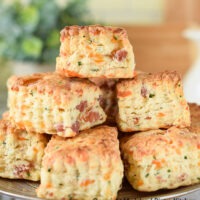
Ham, Cheese, and Chives Savory Scones
Ingredients
- 2 cups all-purpose flour (10 oz/282g – See Note 1 below)
- 1½ tbsp granulated sugar
- 1 tbsp baking powder
- Scant ½ tsp fine sea salt
- 1/8– ¼ tsp garlic powder
- 1/8– ¼ tsp onion powder
- 1/16 tsp cayenne or paprika
- ½ cup cold unsalted butter, cut into ½“ cubes
- 3oz/84 grams shredded aged cheddar cheese
- 3.5oz/100 grams diced cooked ham (diced into ¼“/6.35mm cubes)
- 3 tbsp finely chopped fresh chives
- 1 large egg (cold), lightly beaten with fork
- ½ cup heavy whipping cream (35%-36%MF) (cold) (with 3/4 tbsp removed and reserved for brushing tops of scones) [no substitutes]
- ¼ cup whole milk or 10%MF cream (cold)
- Approximately 2½ - 3 tbsp melted and cooled butter (plus 1 – 1½ tbsp more if you wish to brush scone tops with melted butter instead of whipping cream)
Instructions
- Line large baking sheet with parchment paper.
- In large bowl, sieve or sift the flours, sugar, baking powder, salt, garlic and onion powders, and cayenne or paprika together. Drop the cubes of butter into the dry ingredients and toss to coat the butter. Cut in the butter with a wire pastry cutter until mixture resembles coarse crumbs or pea-sized pieces. Quickly run fingers through the mixture several times, scooping up bits of the butter here and there and rubbing them into long paper-thin slivers between the thumb and forefinger. It is not necessary to do this with every single piece of butter – just quickly pick several at random.
- Stir in the shredded cheese, diced ham, and chopped chives. Make a well in the center of the dry ingredients.
- In a small bowl or large measuring cup, lightly whisk the egg, whipping cream, and milk (or 10%MF cream) together, just until blended. Pour liquid ingredients all at once into well in center of dry ingredients. Using a fork, stir dough just enough that the liquid is absorbed into the dry ingredients and the dough can be roughly brought together. Dough will be soft and sticky and some floury spots may remain. Transfer dough onto lightly floured work surface, gently working it just until the dry ingredients are barely incorporated and a shaggy dough mass forms. Bring dough together into a ball.
- Roll, or pat, the dough into a rectangle about ¾” (apx. 1.9cm) thick. Brush lightly with half of the melted butter. With dough positioned so the short ends of the rectangle are facing you, and with the aid of a large bench scraper, fold one third of the dough up from the bottom short edge into the center and then fold the other top third down onto the top of the folded two-thirds of dough, just as if folding a business letter. Roll, or pat, the dough down into another rectangle, again about ¾“ (apx. 1.9cm) thick. Brush with remaining melted butter. Fold the dough in half, this time from one of the long sides, finally rolling, or patting, the dough into a neat, tidy rectangle about ¾“ – 1” (apx. 1.9cm – 2.54cm) in thickness.
- Using a sharp knife or bench scraper, cut the dough into apx. 14-16 equal-sized squares, apx. 2” wide, depending on actual thickness of dough. Place scones, about 1” (2.54cm) or so apart, on prepared baking sheet and place in freezer for about 20 minutes (or in refrigerator for 30-35 minutes) to chill and allow butter to firm up.
To make square- or round-shaped scones using a sharp-edged cookie cutter:
- Cookie cutters, instead of a knife or bench scraper can be used to cut out scones. Use a lightly floured, sharp-edged, 2” (5.08cm) square or round cutter to cut scones, as close together as possible, from dough. Push the cutter straight down and out of the dough without twisting it in the process. Re-flour the cutter before cutting out each scone. Gather dough scraps and form into a rectangle from which to cut remaining scones, being careful to work the dough no more than absolutely necessary to bring it together. Transfer scones to prepared baking sheet, placing scones about 1” (2.54cm) apart. Refrigerate for 30-35 minutes (or place in freezer for about 20 minutes) to firm up.
- For either square or round-shaped scones, remove scones from refrigerator/freezer and, using a pastry brush, lightly brush the reserved whipping cream on tops of scones, being careful not to allow any cream to drip down over the sides of the scones. Alternatively, melted butter may be used to brush scone tops, if desired.
To bake scones (square- or round-shaped):
- While scones are chilling, position oven rack in center of oven and preheat oven to 400°F. Bake scones apx. 16-18 minutes, or until they are just light golden brown on the edges and tops are golden tanned. Rotate the baking sheet halfway through the baking time. Remove scones from oven and leave them on the baking sheet for 3-4 minutes before transferring them to a wire rack.
Recipe Notes
To serve: Serve scones warm with butter.
Yield: Apx. 14-16 – 2” (5.08cm) square or round scones (exact number will depend on size of cutter used and thickness of dough).
[Copyright My Island Bistro Kitchen]
Note 1: While different sources may list 1 cup of all-purpose flour as weighing slightly more or less than the weight measures I list for this recipe, the weights I have given in this recipe are based on the amount of flour with which this recipe has been tested – i.e., 1 cup of all-purpose flour (properly filled and levelled), the contents of which weigh 5 ounces (or 141 grams) on my digital scales. Therefore, if 10 ounces (or 282 grams) of all-purpose flour is used, it will be the correct amount for this particular scone recipe.
Note 2: These scones can be made gluten-free by substituting gluten-free 1-to-1, or cup-for-cup, baking flour for the all-purpose flour called for in the recipe and, of course, ensuring all other ingredients used in the recipe are gluten-free.
PIN ME TO PINTEREST!



